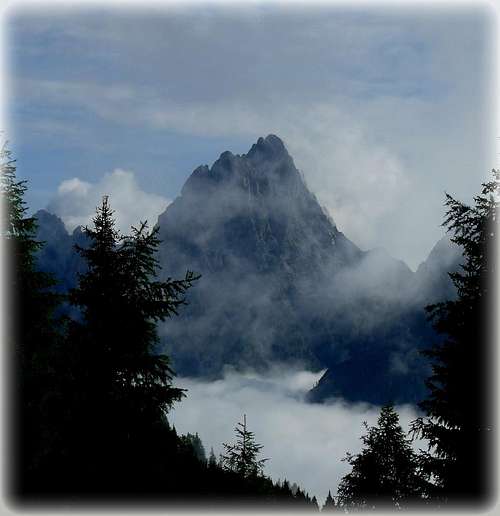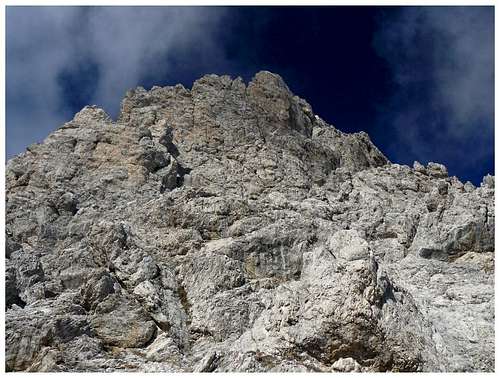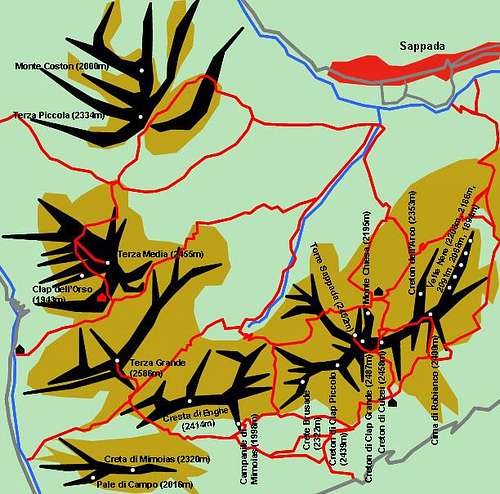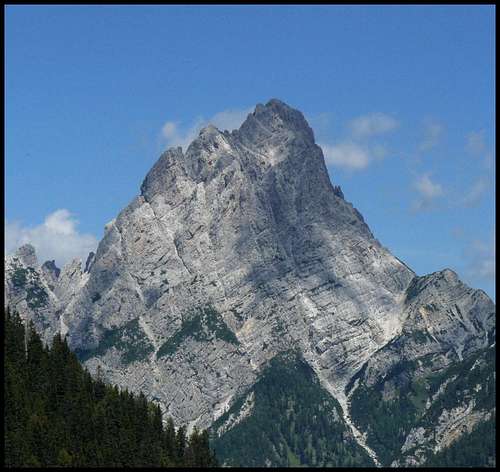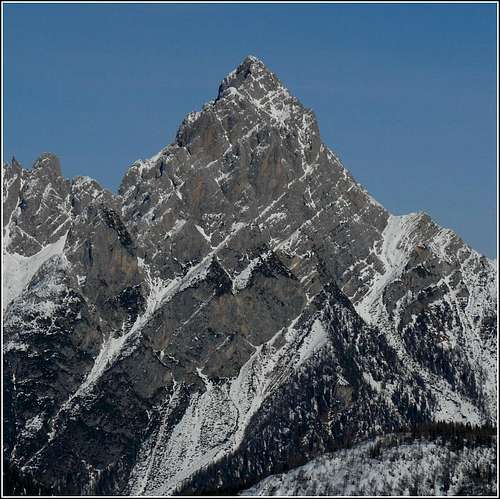|
|
Mountain/Rock |
|---|---|
|
|
46.52200°N / 12.62000°E |
|
|
Hiking, Mountaineering, Trad Climbing, Scrambling, Skiing |
|
|
Spring, Summer, Fall |
|
|
8501 ft / 2591 m |
|
|
Overview
Terza Grande is the third highest summit of the Carnic Alps ( its name means actually “Big Third” ) and the highest of the small dolomitic group known as “Le Terze”, situated among the river Piave, Val Frison, Bosco della Digola and Vallone di Enghe . The other summits of the group are: Terza Media ( 2455 m ), Terza Piccola ( 2334 m ), Monte Coston ( 2000 m ),Cresta di Tolar ( 2167 m ), Croda Casara ( 2372 m ), Monte Fiorito ( 2100 m ), Croda Naie ( 2238 m ).
It is probably the most “dolomitic” peak of the Carnic Alps, entirely carved in the finest Dolomia Principale of the late Triassic age. The other summits of the group formed in a previous period of the Trias age and are composed mainly by Dolomia dello Sciliar.
Terza Grande has two summits, and strangely the highest it’s not the main one. In almost all the books and maps about the Carnic Alps you’ll find that this mountain is 2586 meters high, but its north-east summit ( Antecima Est ) it’s 5 meters higher ( 2591 ). The first mountaineers who climbed the south-west summit ( which today is considered the main one, where you can find the cross and the summit book ) were sure that the other one was the highest, but then for some reason the former was chosen as main summit.
Huge sharp pyramid if seen from south or north and massive rocky bastion from east or west, the unmistakable silhouette of this summit can be recognized even from very far. Its immense north-west face is very intimidating ( 1 km high and 2 km wide ), but also the south and east faces are not less impressive. It’s one of the main goals for all the hikers of the area ( both Italians and austrians ) because its normal route, that can be climbed by an average expert hiker, is without doubt one of the best of this part of the Alps. But the climber also can find very nice and not frequented routes, especially on the eastern faces of the group.
From the summit of Terza Grande you can enjoy one of the most beautiful views of the Eastern Dolomites, because you can see a lot of the famous giants of the group clearly distinct one from another. But all the 360° panorama to the Italian and austrian eastern Alps is absolutely breathtaking.
The first known ascent is of an anonymous group of cartographers that reached the south-west summit in 1820. The north-east summit was ascended for the first time only in 1889 by G.Groger and Veeit Innerkofler . The first winter ascent was of T. Cepich and A.Zanutti in 1907.
Then famous italian alpinists opened routes on all the faces of the mountain:
A. Berti-S. Casara on the north crest, M.Canal-G.Nicoletti on the south face, Zanardi-Celotti-Comelli on the east face and Castiglioni-Pisoni on the mighty north-west face.
Views from Terza Grande
 |
Routes overview
There are many hiking and climbing routes on all the mountains of the group, but all of them require experience. The quality of the rock is not always good, so for difficult climbs it’s better to contact the local alpine clup ( Cai Sappada ).
Terza Grande
>normal route from south south-east
Beautiful normal route that starts from Passo Oberenghe. Quite long but very rewarding, an a superb dolomitic south face. For expert hikers, a few passages of UIAA I/I+. The climb of the north-east summit requires alpinistic experience ( 20 m of UIAA II ).
>From north
400 m UIAA II
>From the north east buttress
190 m UIAA II
>North east shoulder ( 2505 m ) normal route from east
110 m UIAA I
>North east shoulder from north
310 m UIAA II
Harder climbs
>From the south face
600 m UIAA III
>From the north-west face
550 m UIAA III
>From the west south-west crest
450 m UIAA IV
>Via “il gigante buono” – north face of Monte Fiorito
350 m UIAA V+, VI and VII
>Via “dei tempi antichi” – north face of Monte Fiorito
350 m UIAA VI and VII
Terza Media
>Normal route from west
It’s the most demanding among the normal routes of the three Terze and not often climbed. From Val Frison ( rifugio volontari alpini Feltre Cadore )take the path n°310 that goes up towards east to Bivacco Marta Franco. From there follow the path that goes towards north and will take you to a small notch at 2050 m. Then just follow the red dots on the big north-west crest of the mountain. The technical difficulty is not very high ( I/II ) but there are several exposed passages that require secure step and experience. On the way there are a few spits and an iron rope.
>north face
500 m UIAA III
>from east
550 m UIAA II
Terza Piccola
>Normal route from east
This route is not often climbed though from the summit you can enjoy one of the best views of the area, especially to the Carnic Alps and to the Dolomiti di Sesto ( and of course to the other two terze ). From Lerpa ( Sappada ) take the path n°313/311 to Passo della Digola. At the crossroad at 1540 take the path on the right to Forcella della Terza Piccola ( 2188 m ). Follow the track on the western slopes of the mountain that goes up trough scree ravines until you reach the meadows on the summit of the mountain. For expert hikers, short passages of UIAA I/II.
>from south south-west
300 m UIAA I
>from the north crest
330 m UIAA II
Cresta di Tolar
>From north
UAIAA I-
Croda Casara
>from the west face
250 m UIAA III
Monte Fiorito
>From the south south-west face
520 m UIAA I
Croda Naie
>From north-west
160 m UIAA II
Croda Casara
>from the big dihedral between Croda Casara and Forcella Naie
350 m UIAA IV and V
>from the north buttress
450 m UIAA IV
Getting There
You can approach Terza grande from Val Frison, Val Pesarina or from Sappada.
From the Brennero motorway exit Bressanone/Brixen and then S.Candido- Passo di Monte Croce Comelico- S.Stefano di Cadore-Campolongo-Val Frison
Or S.Stefano di Cadore-Sappada
From the Udine-Tarvisio motorway exit Carnia and then Tolmezzo-Villa Santina-Val Pesarina-Forcella Lavardet-Val Frison
Or Tolmezzo-Villa santina-Forni Avoltri-Sappada
From Venezia to Belluno-Pieve di cadore-Lozzo di Cadore-Sella Ciampigotto-Forcella Lavardet-Val Frison
Or Sella Ciampigotto-Val Pesarina
Or Pieve di Cadore-S.Stefano di Cadore-Sappada
The road of Val Frison is often closed for landslides and in bad conditions. If you choose this approach ask for info in Sappada, Campolongo or Sella Ciampigotto.
Red tape
No limitations
<! Due immagini su una riga >
When to climb?
April-may to october-november. The best seasons to climb Terza grande are spring and late summer-autumn ( the south faces can be very hot in summer...).
Meteo Veneto and Dolomiti
Accomodation
If you want to hike or climb in this area the best place to stay is Sappada. But if you're looking for a more relaxing place there are also some nice places to stay in Val Pesarina.
Sappada
Val Pesarina
There are also two bivouacs in the area:
Rifugio volontari alpini Feltre Cadore (abandoned, 1281 m, Val Frison )
Bivacco Marta Franco ( western slopes of Croda casara, 2230 m )
Maps and Books
Tabacco 1:25000
01 S.Stefano – Sappada – Forni Avoltri
Alpi Carniche vol II – A.De Rovere – M. Di Gallo
Alpi Carniche – E.Castiglioni – CAI/TCI
Guida escursionistica alle Alpi Carniche – Rino Gabersick – Liberodiscrivere Editore
Sappada – Dai Sentieri alle Vette – G.Borella – Editrice Co.El.
Alpi Carniche – Catena carnica principale e Dolomiti Pesarine – Ettore Tomasi – Comunità montana della carnia
Sappada – Vie normali e classiche – P.Salvini-G.Piller



